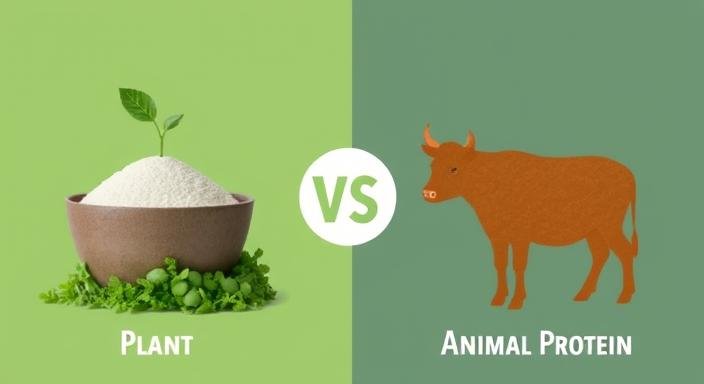Few topics in nutrition spark as much debate as protein. For decades, meat and dairy dominated the conversation—“where do you get your protein?” was practically synonymous with steak, chicken, or eggs. But over the past 20 years, plant-based diets have shifted the narrative. Today, more people are asking: Do we really need animal protein to stay healthy, or can plants do the job just as well?
The conversation isn’t just about health anymore. Environmental concerns and ethical questions are shaping how families choose their food. While some swear by high-protein diets filled with lean meats, fish, and dairy, others argue that legumes, soy, nuts, and whole grains can fuel the body while protecting the planet.
So, what does science really say? Is one source superior, or does the truth lie somewhere in between? This article takes a deep dive into the world of protein—animal and plant—to explore the health benefits, risks, and environmental implications of each, and how individuals can strike a sustainable balance for long-term wellness.
Why Protein Matters
Before weighing sources, it’s important to understand why protein is vital in the first place.
Protein is made of amino acids, often called the “building blocks of life.” They are essential for:
- Muscle maintenance and growth
- Hormone and enzyme production
- Immune system function
- Repair of tissues after injury or illness
Of the 20 amino acids, 9 are considered essential, meaning the body cannot produce them and must get them from food.
The quality of a protein source depends on whether it provides all essential amino acids in sufficient quantities, as well as its digestibility and nutrient package. This is where the plant vs animal debate begins.
Animal Protein: Strengths and Weaknesses
Strengths
- Complete Protein Sources
Animal proteins (meat, poultry, fish, eggs, dairy) are “complete,” providing all nine essential amino acids in optimal proportions. This makes them highly effective for muscle building and repair. - High Bioavailability
The body absorbs and uses animal protein efficiently, which is especially important for athletes, older adults, and people recovering from illness. - Rich in Key Nutrients
Animal foods provide iron, vitamin B12, zinc, and omega-3 fatty acids—all nutrients that can be harder to obtain in sufficient amounts from plants alone.
Weaknesses
- Potential Health Risks
Excess red and processed meats are linked to higher risks of cardiovascular disease, type 2 diabetes, and certain cancers. Saturated fat and sodium are often culprits. - Environmental Impact
Animal farming contributes significantly to greenhouse gas emissions, deforestation, and water usage. Beef production, in particular, has one of the largest ecological footprints. - Ethical Concerns
For many, concerns about animal welfare influence their decision to reduce or eliminate animal protein.
Plant Protein: Strengths and Weaknesses
Strengths
- Health Benefits Beyond Protein
Plant-based proteins come packaged with fiber, antioxidants, and phytonutrients that protect against chronic diseases. Diets rich in legumes, nuts, and seeds are associated with lower risks of heart disease, obesity, and certain cancers. - Lower Environmental Footprint
Producing plant proteins generally requires fewer resources. Lentils and beans, for instance, need far less water and land than raising livestock. - Weight and Metabolic Benefits
Plant-based diets are often lower in calories and saturated fat, supporting weight management and improved insulin sensitivity.
Weaknesses
- Incomplete Proteins
Most plant proteins (except soy, quinoa, and buckwheat) are incomplete, missing one or more essential amino acids. However, combining foods—like rice and beans—can provide a complete amino acid profile. - Lower Digestibility
Plant proteins are not absorbed as efficiently as animal proteins, meaning higher volumes may be needed to achieve the same effect. - Potential Nutrient Gaps
Vitamin B12, heme iron, and certain omega-3 fatty acids are limited in plant-based diets, requiring careful planning or supplementation.
The High-Protein Diet Trend
High-protein diets—often emphasizing animal sources—have gained popularity for weight loss, satiety, and muscle maintenance. They typically recommend 1.2–2.0 grams of protein per kilogram of body weight daily, compared with the standard 0.8 g/kg.
Benefits
- Increased satiety, leading to reduced calorie intake
- Improved muscle retention during weight loss
- Support for athletic performance and recovery
Concerns
- Excessive reliance on red meat or processed meat can elevate long-term disease risk.
- Very high protein intake may stress the kidneys in individuals with pre-existing kidney issues.
Plant-Based Diets: The Countermovement
Plant-based diets have grown in popularity due to both health and sustainability benefits. These range from vegetarian and vegan diets to “flexitarian” approaches.
Benefits
- Lower LDL cholesterol and blood pressure
- Reduced risk of heart disease and obesity
- Protective antioxidants and anti-inflammatory compounds
Concerns
- Protein adequacy can be a challenge if diets are not well-planned.
- Nutrient gaps (B12, iron, omega-3s) require attention.
Striking a Balance: The Middle Ground
Flexitarian and Mediterranean Diets
Research suggests that the most sustainable path may not be “all animal” or “all plant,” but rather balance. Diets like the Mediterranean diet emphasize plants (vegetables, fruits, legumes, whole grains, nuts) while including fish, poultry, and occasional dairy or lean meats.
This approach combines the strengths of both worlds:
- Adequate complete protein intake
- Heart-protective fiber and antioxidants
- Lower environmental impact compared with heavy meat diets
Practical Tips for Balance
- Mix Protein Sources: Pair plant proteins (beans with rice, hummus with whole-grain bread) for completeness.
- Lean Toward Plants: Use animal protein as a complement, not the centerpiece, of meals.
- Prioritize Quality Over Quantity: Choose lean meats, wild fish, and minimally processed plant proteins.
- Consider Sustainability: Reduce red meat intake; opt for poultry, fish, or legumes more often.
The Environmental Lens
Protein choices don’t just affect personal health—they shape the planet’s future.
- Beef & Lamb: Highest greenhouse gas emissions, land use, and water requirements.
- Poultry & Fish: Lower footprint, but still resource-intensive.
- Legumes, Nuts, Seeds: Significantly more sustainable per gram of protein.
Shifting even part of protein intake toward plants can meaningfully reduce environmental impact without sacrificing nutrition.
Frequently Asked Questions (FAQ)
Q1. Can I build muscle on a plant-based diet?
Yes. With careful planning, combining legumes, grains, and soy-based products provides sufficient protein for muscle growth. Many athletes thrive on plant-based diets.
Q2. Do I need to eat meat every day to stay healthy?
No. Nutrients found in meat can be obtained through a balanced mix of plant proteins, fortified foods, and supplements if necessary.
Q3. Is red meat always bad for health?
Moderation is key. Lean cuts and limited portions can be part of a healthy diet, but frequent consumption of processed or fatty red meats increases health risks.
Q4. What about protein powders—are they necessary?
Not for most people. Whole foods should be the foundation. Powders can be useful for athletes or those struggling to meet needs through food alone.
Q5. Which diet is better for the planet?
Plant proteins have a much lower environmental impact. Even reducing animal protein consumption by half can make a significant difference.
The debate over plant vs animal protein often falls into extremes—but the most sustainable and healthful path lies in balance. Animal proteins offer completeness and efficiency, while plant proteins deliver fiber, antioxidants, and environmental benefits.
For long-term wellness, a diet rich in plants, complemented by moderate amounts of high-quality animal protein, seems to offer the best of both worlds. This approach supports not only human health but also planetary sustainability. In the end, the question isn’t whether to choose plant or animal protein—it’s how to use both thoughtfully to fuel healthier bodies and a healthier planet.





